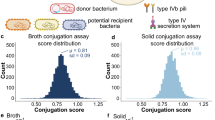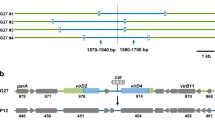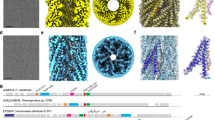Abstract
Bacterial conjugation is an active process that results in unidirectional transfer of DNA from a donor to a recipient cell. Most transfer systems are plasmid-encoded and require proteins to act at a unique cis-acting site to initiate and complete DNA transfer. By contrast, the Mycobacterium smegmatis DNA transfer system is chromosomally encoded. Here we show that multiple cis-acting sequences present on the chromosome can mediate transfer of a non-mobilizable test plasmid. Moreover, unlike conventional plasmid transfer, recipient recombination functions are required to allow this plasmid, and derivatives of it, to re-circularize through a process similar to gap repair. Extended DNA homology with the recipient chromosome is required to facilitate repair, resulting in acquisition of recipient chromosomal DNA by the plasmid. Together, these results show that DNA transfer in M. smegmatis occurs by a mechanism different from that of prototypical plasmid transfer systems.
This is a preview of subscription content, access via your institution
Access options
Subscribe to this journal
Receive 12 print issues and online access
$209.00 per year
only $17.42 per issue
Buy this article
- Purchase on Springer Link
- Instant access to full article PDF
Prices may be subject to local taxes which are calculated during checkout



Similar content being viewed by others
Accession codes
References
Waters, V.L. Conjugation between bacterial and mammalian cells. Nat. Genet. 29, 375–376 (2001).
Buchanan-Wollaston, V., Passiatore, J.E. & Cannon, F. The mob and oriT mobilization functions of a bacterial plasmid promote its transfer to plants. Nature 328, 172–175 (1987).
Heinemann, J.A. & Sprague, G.F. Jr. Bacterial conjugative plasmids mobilize DNA transfer between bacteria and yeast. Nature 340, 205–209 (1989).
Firth, N., Ippen-Ihler, K. & Skurray, R.A. Structure and function of the F factor and mechanism of conjugation. in Escherichia coli and Salmonella Cellular and Molecular Biology Vol. 2 (ed. Neidhardt, F.C.) 2377–2401 (American Society for Microbiology Press, Washington, D.C., 1996).
Zechner, E.L. et al. Conjugative–DNA transfer processes. in The Horizontal gene pool, bacterial plasmids and gene spread (ed. Thomas, C.M.) 87–174 (Harwood Academic Publishers, Amsterdam, 2000).
Lanka, E. & Wilkins, B.M. DNA processing reactions in bacterial conjugation. Annu. Rev. Biochem. 64, 141–169 (1995).
Mizuguchi, Y. & Tokunaga, T. Recombination between Mycobacterium smegmatis strains Jucho and Lacticola. Jpn. J. Microbiol. 15, 359–366 (1971).
Parsons, L.M., Jankowski, C.S. & Derbyshire, K.M. Conjugal transfer of chromosomal DNA in Mycobacterium smegmatis. Mol. Micro. 28, 571–582 (1998).
Derbyshire, K.M. & Bardarov, S. DNA transfer in mycobacteria: conjugation and transduction. in Molecular genetics of mycobacteria (eds. Hatfull, G.F. and Jacobs, W.R.) 93–107 (American Society for Microbiology Press, Washington, D.C., 2000).
Wollman, E.-L., Jacob, F. & Hayes, W. Conjugation and genetic recombination in Escherichia coli K-12. Cold Spring Harb. Symp. Quant. Biol. 21, 141–162 (1956).
Warren, G.J., Twigg, A.J. & Sherratt, D.J. ColE1 plasmid mobility and relaxation complex. Nature 274, 259–261 (1978).
Lloyd, R.G. & Low, K.B. Homologous recombination. in Escherichia coli and Salmonella Cellular and Molecular Biology Vol. 2 (ed. Neidhardt, F.C.) 2236–2255 (American Society for Microbiology Press, Washington, D.C., 1996).
Haber, J.E. DNA recombination: the replication connection. Trends Biochem. Sci. 24, 271–275 (1999).
Smith, G.R. Conjugational recombination in E. coli: myths and mechanisms. Cell 64, 19–27 (1991).
Canosi, U., Iglesias, A. & Trautner, T.A. Plasmid transformation in Bacillus subtilis: effects of insertion of Bacillus subtilis DNA into plasmid pC194. Mol. Gen. Genet. 181, 434–440 (1981).
Bhatt, A., Kieser, H.M., Melton, R.E. & Kieser, T. Plasmid transfer from streptomyces to Mycobacterium smegmatis by spontaneous transformation. Mol. Microbiol. 43, 135–146 (2002).
Hopwood, D.A. & Kieser, T. Conjugative plasmids of streptomyces. in Bacterial Conjugation (ed. Clewell, D.B.) 293–312 (Plenum, New York, 1993).
Wu, L.J., Lewis, P.J., Allmansberger, R., Hauser, P.M. & Errington, J. A conjugation-like mechanism for prespore chromosome partitioning during sporulation in Bacillus subtilis. Genes Dev. 9, 1316–1326 (1995).
Maas, R.M., Gotz, J., Wohlleben, W. & Muth, G. The conjugative plasmid pSG5 from Streptomyces ghanaensis DSM 2932 differs in its transfer functions from other streptomyces rolling-circle-type plasmids. Microbiology 144, 2809–2817 (1998).
Ducote, M.J., Prakash, S. & Pettis, G.S. Minimal and contributing sequence determinants of the cis-acting locus of transfer (clt) of streptomycete plasmid pIJ101 occur within an intrinsically curved plasmid region. J. Bacteriol. 182, 6834–6841 (2000).
Pettis, G.S. & Cohen, S.N. Transfer of the plJ101 plasmid in Streptomyces lividans requires a cis-acting function dispensable for chromosomal gene transfer. Mol. Microbiol. 13, 955–964 (1994).
Papavinasasundaram, K.G., Colston, M.J. & Davis, E.O. Construction and complementation of a recA deletion mutant of Mycobacterium smegmatis reveals that the intein in Mycobacterium tuberculosis recA does not affect RecA function. Mol. Microbiol. 30, 525–534 (1998).
Jacobs, W.R. Jr. et al. Genetic systems for mycobacteria. Methods Enzymol. 204, 537–555 (1991).
Donnelly-Wu, M.K., Jacobs, W.R., Jr. & Hatfull, G.F. Superinfection immunity of mycobacteriophage L5: applications for genetic transformation of mycobacteria. Mol. Micro. 7, 407–417 (1993).
Garbe, T.R. et al. Transformation of mycobacterial species using hygromycin resistance as a selectable marker. Microbiol. 140, 133–138 (1994).
Griffin, T.J. et al. In vitro transposition of Tn552: a tool for DNA sequencing and mutagenesis. Nucleic Acids Res. 27, 3859–3865 (1999).
Altschul, S.F. et al. Gapped BLAST and PSI-BLAST: a new generation of protein database search programs. Nucleic Acids Res. 25, 3389–3402 (1997).
Corpet, F. Multiple sequence alignment with hierarchical clustering. Nucleic Acids Res. 16, 10881–10890 (1988).
Acknowledgements
We dedicate this article to the memories of S. Bardarov and J. Colston, who were friends and a stimulating intellectual force behind this work. We thank J. Colston for the recA disruption plasmids; C. Takacs, J. Flint, T. Ichiyanagi and A. Waring for technical assistance; and M. Belfort, J. Curcio, V. Derbyshire, D. Figurski, D. Nag, H. Taber and N. Tavakoli for critical comments. This work was supported by a grant from the US National Institutes of Health to K.M.D.
Author information
Authors and Affiliations
Corresponding author
Ethics declarations
Competing interests
The authors declare no competing financial interests.
Supplementary information
Rights and permissions
About this article
Cite this article
Wang, J., Parsons, L. & Derbyshire, K. Unconventional conjugal DNA transfer in mycobacteria. Nat Genet 34, 80–84 (2003). https://doi.org/10.1038/ng1139
Received:
Accepted:
Published:
Issue Date:
DOI: https://doi.org/10.1038/ng1139
This article is cited by
-
Genome-wide mosaicism within Mycobacterium abscessus: evolutionary and epidemiological implications
BMC Genomics (2016)
-
Mobile genetic elements: the agents of open source evolution
Nature Reviews Microbiology (2005)
-
Conjugal rites of mycobacteria
Nature Genetics (2003)



